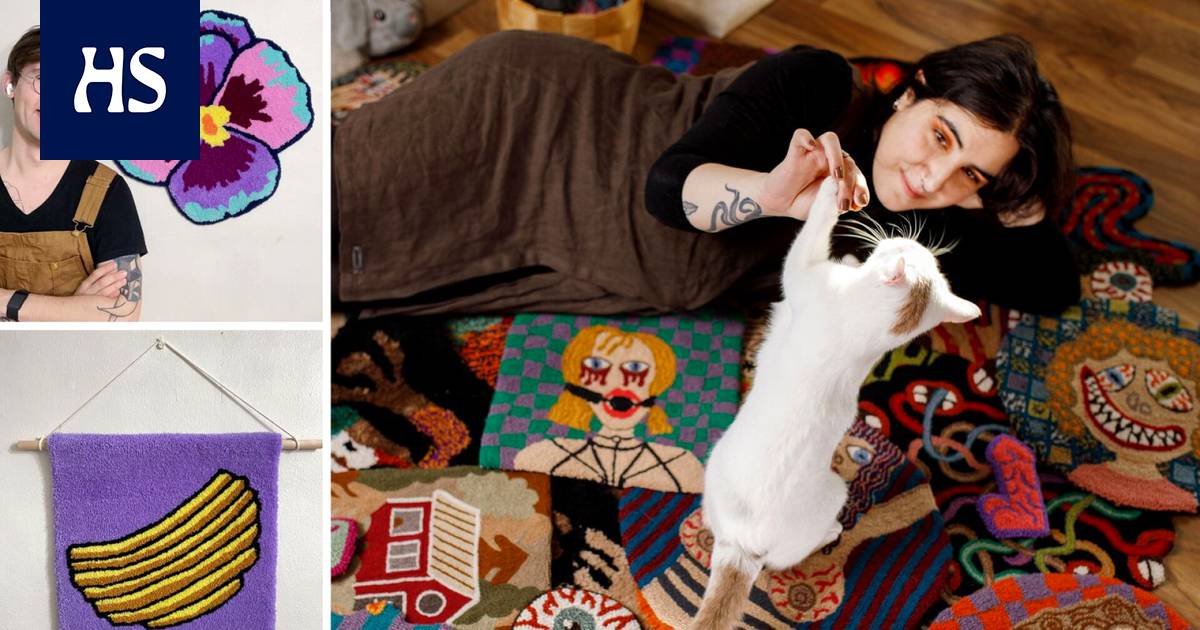Tufting became a trendy form of self-expression: it can be used to make simple pop art patterns or original textile art. Some re-popularized the old craft technique.
Fur native Bachelor of Laws Deniz Hartikainen moved to Finland in 2017. The reason was the ordinary love that ignited during the exchange year. Hartikainen’s goal was to continue his studies in his new home country and graduate as a lawyer.
However, the entrance exam did not go to the button, so there was an intermediate year ahead. It marked a turning point in his life: Law changed to making art.
“I was bored, so I started making tufts of little rugs. Gradually I found my own style. With my rugs, I tell stories about things that make me think. ”
So far, Hartikainen has had two art exhibitions, the first last summer at Laterna Magica in Helsinki and the second just finished in Galleria Muuntotila in Tampere. He is currently in Vaasa, invited by the Vaasa Artist Residence.
Deniz Hartikainen tells stories about things that make her think.
Hartikainen says that certain themes, such as the concept of gender and the position of queer people in Turkish society, only really opened up to him in Finland.
“The status of women and minorities here is very different from my country of birth. In Turkey, all matters relating to women and nudity are political. President Erdogan demeaning queer people in their speeches, and it bothers and saddens me, ”Hartikainen explains.
Today, instead of individual rugs, he is interested in installations whose effect is based on repetition and color. The ensemble of dozens of small tufted penises looks whimsical. The colors of the rainbow add to the twist.
Museum lecturer at the Finnish Craft Museum Raija Mannisen according to Deniz Hartikainen is an example of an author who has developed a strong own style for himself.
“His style is different from all the others I’ve seen. Deniz has its own world of patterns and colors, with the influence of Turkish culture behind it. ”
Deniz Hartikainen’s rugs. According to museum lecturer Raija Manninen, Deniz Hartikainen is an example of an author who has developed a strong style of his own.
Chance, some and content. It contains three things that unite Deniz Hartikainen from Jyväskylä and his colleagues living in Helsinki Heidi Linsén and Joonas Saloa. The popularity of modern rugs has surprised them all. Textiles made by tufting are selling so well that Salokin, who has worked as a magazine photographer for years, has just become a full-time craftsman.
Tufting comes from the English word tuft, which means lint. Hand tufting resembles painting and can be used to create spectacular textile surfaces.
According to Manninen, the popularity of tufting is based, among other things, on the fact that the technology is easy and fast, and it does not require much equipment or space. Manninen compares tufting to another popular technique, a macrame in which knots are tied.
Today, instead of individual rugs, Deniz Hartikainen is interested in installations whose effect is based on reproduction and color.
Tufting requires a tufting needle, thread and a backing fabric with frames. The frame can be a small, lap-like canvas or a large fabric stretched in vertical trees. The pattern is created by injecting successive stitches into the fabric with a tufting needle, and the thread passing between the stitches “paints” the pattern. The work is usually done from the wrong side and the fluff comes to the right.
Taitoliitto, which promotes the handicraft tradition in Finland, sells tufting packages that include tools, threads and finished models. You can also draw the pattern on the backing fabric yourself. The diversity of tufted rugs and their expressive power is based on this. Each rug looks like its draftsman and tuft.
According to Manninen, behind the tuft boom is also the fact that people now spend a lot of time in front of computers and other smart devices.
“Many want something to do with concrete at hand. If necessary, you can also take on an additional challenge – the more complex the pattern and the more yarns of different colors and thicknesses, the harder it is to tuft. ”
Joonas Salo also makes rugs to order.
Traditional rugs are usually rectangular in shape and their subjects are related to flowers, plants, or geometric shapes. Modern rug, on the other hand, can be of any shape.
“Sipsi ryi quickly started to spread in some. People often order something similar to what they have seen elsewhere. I don’t do the same thing, but everyone is unique, ”says Joonas Salo.
Joonas Salo’s catalog of rugs often refers to pop art. His plasterboard has been of particular interest to people.
Salo got excited about tufting a year ago when he missed a new hobby. Making handicrafts was familiar from childhood and adolescence, so he decided to try tufting. The carpet in the living room he made for his home became successful and friends asked Salo to make tufted rugs for them as well.
He soon began making rugs as well. Their world of color and form is reminiscent of popular culture such as comics and pop art.
Salo says he learned the technology of tufting through Youtube videos. Linsén and Hartikainen have also taken advantage of the videos. Instagram is an important channel for all of them, both in terms of following other tufts and sharing their own work.
“I accidentally hit the right moment, I didn’t know that rugs have come into vogue again. From childhood, I remember my grandmother’s traditional rug, the kind made by tying. My rugs are modern, but they bring to mind familiar and cozy things. The popularity of tufted rugs is probably partly based on that, ”Joonas Salo reflects.
Tufting is not a new craft technique, but a new coming of an old tradition. It comes from the United States, where women in rural poverty made old fabrics out of old fabrics, such as rugs and seat cushions. The technology later evolved into tufting as it is known today.
The technology became widespread in the early 20th century. Tufting became easier and more popular at the same time as the American Oxford Company developed the tufting needle into its current shape in the 1980s. As a result, tufting also became more common in Finland.
In the old days, rugs were made by women who had a place at home with their children. Today, the position of the woman is different, which is also reflected in the choices of topics. The subject of a modern rug can be anything: kissing lips, penises, or eyeballs.
Yarns for Deniz Hartikainen’s future rugs.
The change to the past is radical. In its own way, textile art takes part in the ongoing social debate.
“With rugs, I raise issues that are important to me, such as equality between people,” says Deniz Hartikainen. “I criticize a machoculture that is stronger in Turkey than in Finland. With the help of rugs, I also work on my own insecurities and fears. It feels like I got my voice back with the help of rugs. ”
Heidi Linsén is known for her humorous and provocative lipsticks, with which she criticizes the iconic image of women.
Heidi Linsén, who declares herself a feminist, also wants to bring out her own voice. The corona pandemic took over the work of Linsén, who works in the cultural sector as an event spokesperson, and everyday life fell silent. It made him think about what he really wants out of his life.
“I’ve been drawing and painting all my life. However, no tool or technique felt my own, but I was looking for my own way of expressing myself. One night I was surfing the web, and the tufting came by chance at Tiktok, ”says Linsén.
The actual tufting fever struck when Linsén received a tufting gun as a gift. It quickly creates attractive-looking textile surfaces. At times, however, there were moments of despair when an overly stretched backing fabric tore, and hours of work were wasted. Linsén continued to train diligently and gradually found his own style.
Today, she is known for her humorous and provocative lipsticks, with which she criticizes the iconic image of women and the stereotypes associated with femininity. He is currently preparing for an exhibition that will open in April. The lip theme continues, but now the black-and-white lips are under construction instead of the glaring red ones.
“In this world, colors disappear,” says Linsén.
Deniz Hartikainen, Rugs on drugs, Bar Constant pressure, Jyväskylä, April 1–31, 2022.
Heidi Linsén, Encore trop, Puukonttorin gallery, Nuutajärvi, 1 April – 31 May 2022
A modern burger rug made by Joonas Salon.
Croissant-themed rug made by Joonas Salo.
Heidi Linsén’s rug You didn’t, Albert.
Rugs made by Deniz Hartikainen.
Rugs made by Deniz Hartikainen.
#Art #Sipsiryiji #started #spread #Joonas #Salo #left #work #magazine #photographer #fulltime #craftsman #Modern #tufted #rugs #hands #creators









